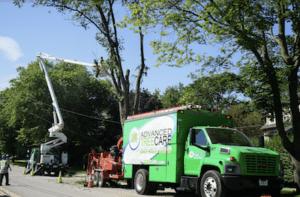You’ve heard us tell you before: proper tree care can be complex. Caring for trees, treating or preventing disease, and safely removing a tree all take a significant amount of knowledge and experience. When considering which company to hire for tree care, you should always choose a service led by a certified arborist. Such a service—like ours—will always deliver superior comprehensive service.
But what does it take to become an arborist? And what does certification really mean? In this article, we take you behind the scenes, so you can truly appreciate what goes into that level of knowledge and care.
Becoming an ISA Certified Arborist

First off, when we talk about certification, we’re talking about qualifying as an International Society of Arboriculture (ISA) Certified Arborist. To qualify, an arborist must have at least three full years of full-time experience in arboriculture. This experience must be hands-on and typically includes:
- Tree pruning
- Tree cabling and bracing
- Tree fertilization
- Tree planting, or called installation and establishment of trees
- Diagnosis and treatment of tree problems and diseases
- And, not least of all, tree climbing
Why so much experience, across so many different aspects of the job? ISA certification means that an arborist is prepared to provide the benefit of his or her maximum expertise to the care of trees across a range of situations: from commercial or municipal properties to residential situations, through all four seasons (in our area), and in routine and emergency situations. That level of professional certification requires contending with every aspect of the job for full preparation.
ISA Certification Exam
Three years’ experience isn’t sufficient alone. After providing evidence of three full years of experience across all those functions, the arborist must study for and take an examination. The topics of the certification exam include questions on:
- Soil management
- The proper identification and selection of trees
- Installation and establishment of trees
- Safe work practices
- Tree biology
- Pruning, cabling, and bracing
- Diagnosis and treatment of conditions and diseases
- Urban forestry
- Tree protection
- Tree risk management
After successfully passing the examination, the arborist agrees to a set of ethics that will govern his or her professional behavior. The arborist then receives a certificate with the ISA seal, which designates him or her as an official ISA Certified Arborist.
Certification is valid for three years, and continuing education is required to maintain certification. Before the three years are up, the arborist must become recertified—which happens either through retaking the certification exam or by accruing at least 30 continuing education credits.
Now that you know what becoming an arborist requires, you’ll understand why our professionals can deliver an outstanding level of service for the care of your trees.
Advanced Tree Care combines top-notch equipment, cutting-edge technology, and well-trained staff to provide emergency tree removal and tree maintenance services. With a presence in nine counties and two states, we work daily to provide unparalleled customer service, safety, and efficiency—as well as the expertise to beautify your landscaping and community. Advanced Tree Care isn’t just our name—it’s also our purpose!